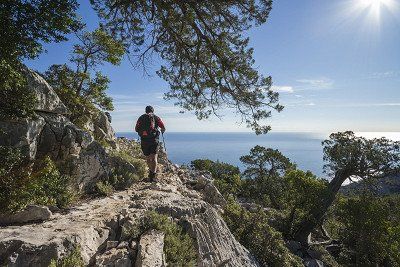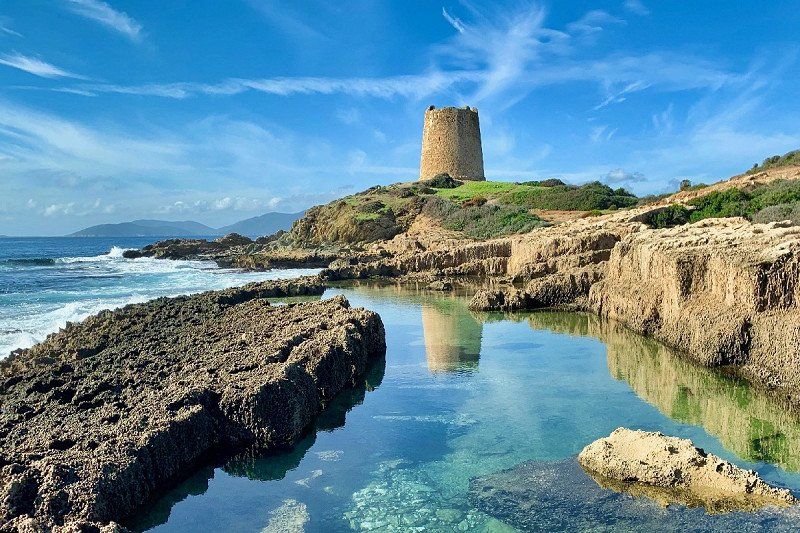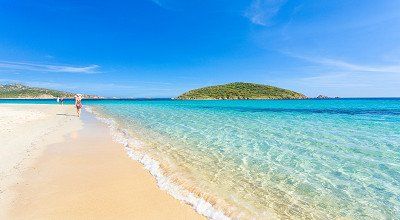Sardinia is the second largest island in the Mediterranean, boasting a contrasting nature and a fascinating play of light and colour across the landscape as well as a turquoise blue sea paired with fantastic beaches. But caravanners and motorhome owners will also be able to discover a host of treasures beyond the beaches, especially in the off-season. Freeontour presents its top 10 highlights of Sardinia, which would incidentally make a great itinerary for a motorhome trip around this Italian haven.
Useful information about travel times, campsites, traffic regulations for campers and how to get to Sardinia can be found here:
Contents
Tip #1: Hiking through limestone cliffs on the Baunei coast
Tip #2: Hiking and climbing tour in the Gola di Gorropu gorge
Tip #3: Discovering Nuraghic culture
Tip #4: Relaxation for beachcombers on the Costa Rei
Tip #5: Sightseeing and culture in Cagliari
Tip #6: Searching for clues in the ruins of the ancient city of Tharros
Tip #7: Cave tour at Capo Caccia
Tip #8: Strolling through Alghero
Tip #9: Snorkelling and climbing at Capo Testa
Tip #10: Boat trip to La Maddalena National Marine Park

Tip #1: Hiking through limestone cliffs on the Baunei coast
Experience unspoilt Sardinia by spending a few days on the east coast near the village of Baunei. Towering over a beautiful part of the coast, its beaches and bays can only be reached by water or spectacular hiking trails, thus making them less frequented. You can explore a few gorges and karst caves here – your feet will remain dry in some, you'll need a snorkel and fin for others. Baunei is framed from the interior by the Supramonte Mountains. You won't regret hiking to the Su Sterru karst grotto above Baunei either. Around 270 m deep and a gorge that is 25 m wide, it's one of the deepest caves in Sardinia and home to exciting fauna, such as the Sardinian cave salamander.

Tip #2: Hiking and climbing tour in the Gola di Gorropu gorge
The Gola di Gorropu gorge in the Supramonte mountains is one of the most breathtaking natural landscapes in Sardinia and one of the deepest gorges in Europe, with rock walls soaring up to 500 m. All you need to bring with you are sturdy shoes and a positive attitude to climbing over rocks and scree because the gorge insists on its visitors making some effort before it reveals its most beautiful spots. Most hikers set off to the gorge from the official car park next to a bridge over the dry riverbed. You can get here by exiting the SS 125 at Dorgali at the sign for Gola su Gorropu and then following the road for about 10 km.
Please note: the road is quite narrow and can be challenging for motorhomes and campervans when there is oncoming traffic. We, therefore, recommend staying overnight at the small campsite at the Silana Pass and then descending down to the gorge from the campsite. If you don't feel like trudging all the way back up, you can treat yourself to a jeep shuttle back to the campsite at the end of the gorge. There's an entrance fee of €5 per person to access the gorge (as of 2022).

Tip #3: Discovering Nuraghic culture
Sardinia is known for its Nuraghic civilisation, which dates back to around 1600 to 400 BC. It has left prehistoric, tower-shaped stone structures from the Bonnanaro culture, often surrounded by stone hut villages. There are roughly 7,000 of these above-ground nuraghi scattered around Sardinia today. However, for the most part, no one is quite sure what they were used for – they could have been temples, fortresses, astronomical observatories or even homes of tribal leaders. Sometimes they are also found near other megalithic monuments from a previous era, such as domus de janas, menhirs and dolmens. You'll also find other places of worship nearby, e.g. Nuraghic holy wells and giants' tombs.
Su Nuraxi near Barumini is a UNESCO World Heritage Site and one of the most famous Nuraghic excavation sites. The archaeological area includes a Nuraghic complex and a huge village of huts, both built with basalt from the nearby Giara Natural Park. Not too far away is also the Nuraghe Arrubiu in Orroli – a very rare example of a nuraghe with a cinquefoil. The central tower is surrounded by five other towers, which in turn are surrounded by a defensive wall with seven towers. The megalithic complex has several courtyards inside.

Tip #4: Relaxation for beachcombers on the Costa Rei
If you're hoping to relax between a natural oasis and miles of white sandy beaches, then plan a few days on the Costa Rei in the southeast of the island. The best thing: the journey through the Sarrabus region goes along a panoramic road where you'll be tempted to stop after every bend to enjoy the views. If you also want to continue towards Cagliari, take the coastal road instead of the clearway. The downside: the Costa Rei is no longer an insider tip. Italian tourists and Sardinians flock to this region during peak season and at weekends. However, it's a lot quieter here in the off-season.

Tip #5: Sightseeing and culture in Cagliari
If you're interested in architecture and culture, then you have to visit Cagliari, the capital of Sardinia. There are so many stunning sights that you can easily spend several days here. Sardinia's largest city has so far managed to avoid mass tourism. Although large cruise ships do dock in Cagliari regularly, you can still enjoy an appealing mix of Mediterranean flair, history, art, the sea and great cuisine – and still find time to do some shopping. It almost goes without saying that you should park your vehicle, whether it’s a car or a campervan, at a campsite, RV park or car park on the outskirts of Cagliari and then cycle or take the bus to the city centre.

When visiting the Sardinian capital, most holidaymakers aim to visit the four historic districts of Cagliari, which have preserved evidence of the region's millennia-old history, ranging from prehistory to the Savoy dynasty. The Castello castle district lies on top of the highest hill in the city and is characterised by ancient bastions and picturesque streets lined with noble residences, including the Palazzo Regio, the Palazzo di Città and the Cathedral of Santa Maria. What stands out in particular are the medieval towers at the entrance to the castle, Torre dell'Elefante and Torre di San Pancrazio. Other architectural highlights here are the Convent of San Domenico, the Basilica of San Saturnino and the Basilica of Nostra Signora di Bonaria.
At the foot of the castle is the Marina district, known for its beautiful buildings and arcades on Via Roma, including Palazzo Civico, the town hall. The Church of Sant'Eulalia with valuable remains from the Roman period is nearby. In the historic district of Stampace, you'll find the Baroque Church of Sant'Anna in one of the narrow streets. A few metres from the historic centre is the Amphitheatre, one of the most important Roman testimonies in Sardinia, and the Botanical Garden.

Venture outside the city centre and visit the Castle of San Michele or Tuvixeddu, the largest Phoenician-Punic necropolis in the Mediterranean (6th-3rd centuries BC). But before you leave Cagliari, you should definitely go to the Cagliari Lagoon and explore it either on foot or by bike.
The famous greater flamingos have lived here for more than 25 years, with its population now estimated at 25,000 birds. The best time of day to watch the flamingos and to take fascinating photos is just before sunset when the red evening sky makes their pink plumage shine even more intensely.

Tip #6: Searching for clues in the ruins of the ancient city of Tharros
The ruins of the ancient city of Tharros can be found in a spectacular location on the southern tip of the Sinis peninsula in the west of Sardinia, which is at times only 100 m wide. You'll find evidence of more than two millennia of history here as Tharros' roots include a Nuraghic settlement, a Phoenician empire, a Carthaginian fortress as well as a city colonised by the Romans and the Byzantines. The ruins of the ancient city built in the 8th century BC and abandoned in the 11th century AD now form an open-air archaeological park that stretches for about 2.5 km. You can see the remains of an acropolis, a 120 m long pier from Punic times, a thermal bath, several temples, old Roman roads and the remains of the former Nuraghic settlement. Most visitors climb up the tower to enjoy the great panoramic view over the sea.
Not too far away is the town of Cabras where you can visit the Giovanni Marongiu Municipal Archaeological Museum and see a variety of finds from Tharros as well as five of the Giants of Mont'e Prama. The rest of the stone giants are in the National Archaeological Museum of Cagliari.

Tip #7: Cave tour at Capo Caccia
On the northwest coast of Sardinia, about 25 km northwest of the city of Alghero, which is also a stunning place to visit, lies the spectacular headland of Capo Caccia. Largely a nature reserve and somewhat reminiscent of Ireland's Cliffs of Moher, it's worth hiking to the Belvedere viewpoint along the steep rocky cliffs made of waves of rock to enjoy the breathtaking views. If you want to find out what attracts thousands of tourists here every year, you'll have to climb more than 100 m down to the sea via a stone staircase with more than 600 steps cut into the cliff. A total of 15 karst grottos shaped by nature are hidden below the rocks. The gigantic Grotta di Nettuno (Neptune's Grotto) stalactite cave is undoubtedly one of the highlights and a magnet for visitors. You'll also be amazed by the impressive karst formations where nature has created large halls full of stalactites and stalagmites, a dazzling white sandy beach and a huge underground lake.

Neptune's Grotto stretches horizontally for about four km at sea level and is considered to be the largest sea cave in the Mediterranean. However, only a few hundred metres of the grotto can be accessed by the public, and temperatures in the cave are about 10 °C all year round. So don't forget to take something warm with you as well as sturdy shoes. If you don't feel like going down the stairs to get to the grotto, then take a short boat trip from Alghero or Porto Conte to Neptune's Grotto from April to October when the weather is calm. If you do want to climb down the stairs, make sure you look at the sea and rocks from time to time as monk seals, dolphins, white-chinned petrels as well as birds of prey feel at home in the Marine Protected Area around Capo Caccia.

Tip #8: Strolling through Alghero
Hardly any other place in Sardinia has as many hotels as Alghero, the fifth largest city on the island. Tourism is significantly more developed here than in Cagliari and other places, which is also reflected in the high number of souvenir shops and shops selling jewellery made from coral sourced from the local coral coast. Nevertheless, when here in the off-season, you should at the very least make time for a stroll through the Old Town of Alghero, which is regarded as one of the most beautiful old towns in Sardinia.
The Old Town with its cobblestone streets and historic city wall is dominated by Catalan-Gothic architecture, of which the Cathedral of Saint Mary the Immaculate with its high bell tower, the Palazzo Guillot and the 14th century Church of San Francesco are particularly fine examples as is the Church of San Michele with its colourful dome made of earthenware bricks. Make sure you take a walk along the bastions of the harbour. And if you're interested in corals, visit the Coral Museum where you can learn a lot about these fascinating cnidarians, which have formed a large colony on the local coast.

Tip #9: Snorkelling and climbing at Capo Testa
At the northernmost tip of Sardinia, on the Capo Testa peninsula, mighty boulders lure you in, their bizarre shapes and structures carved by the wind and water. You can roam for hours between the rocks and then swim or snorkel in one of the small bays. At times you'll find a small hiking trail, otherwise you'll have to find your own way over the rocks. If you feel up to it, you can also walk to Valle della Luna, the former hippie stronghold where a number of caves and grottos are still inhabited by free spirits in summer, albeit illegally as camping at Capo Testa has not been allowed for several years.
Please note: access to Capo Testa is closed to campervans and motorhomes as the road to the peninsula is very narrow. Instead, look for a parking space on the outskirts of Santa Teresa Gallura and then walk or cycle to the Capo Testa lighthouse. Incidentally, this is also recommended for holidaymakers travelling by car in July and August as it can get quite crowded near the lighthouse in peak season. But if you go over the rocks to get away from the lighthouse, it won't take you long to find a beautiful and quiet spot.

Tip #10: Boat trip to La Maddalena National Marine Park
Caravanners looking for unspoilt Sardinia and its scenic attractions should avoid the famous Costa Smeralda in the northeast. This roughly 55 km stretch of coast between Palau and Olbia was built in the 1960s and 1970s specifically for rich tourists – inventing an architectural style in the process – but at the expense of the shepherds who lived here at the time. Nevertheless, Palau is a good starting point for boat tours to La Maddalena Archipelago National Park, which are also offered from Baja Sardinia, Santa Teresa Gallura and from the main island of Maddalena. It's definitely worth taking a trip out to sea because the national park consists of over 60 small and large islands made of granite and slate whose contours have been shaped by the wind and the waves. If you're into diving or snorkelling, take a boat tour to the shoals of Spargiotello and Washington, Punta Coticcio and Grottino di San Francesco.








































